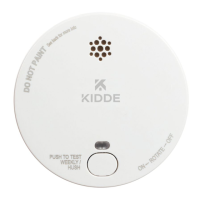9
6. Recommended Locations for Smoke Alarms
NOTE: According to BS 5839-6, for optimal re protection: “The greatest benet to life safety is given by a
full-coverage system. Such a system will give the earliest practicable warning of re to occupants, wherever
ignition occurs.”
• Locate the rst alarm in the immediate area of the bedrooms. Try to monitor the escape routes and rooms
opening into escape routes as the bedrooms are usually farthest from the exit.
• If more than one sleeping area exists, locate additional alarms near each sleeping area. No bedroom door
should be further than 3 m from the nearest alarm.
• Locate additional alarms between every bedroom and every other room in the dwelling (for example, an
ofce, library, or lounge), other than a toilet, bathroom, or shower room.
• Locate additional alarms to monitor any stairway as stairways act like chimneys for smoke and heat.
• Locate at least one alarm on every oor level, including nished lofts. Locate an alarm between each
staircase and every room, other than a toilet, bathroom or shower room.
• Locate an alarm in every bedroom.
• Locate an alarm in every room where electrical appliances are operated (i.e. portable heaters or humidiers).
• Locate an alarm in every room where someone sleeps with the door closed. The closed door may prevent
an alarm not located in that room from waking the sleeper.
• Locate one alarm in each principal habitable room.
• If a habitable room is an inner room with no doors or windows through which escape is possible, locate one
alarm in the room used to access that inner room.

